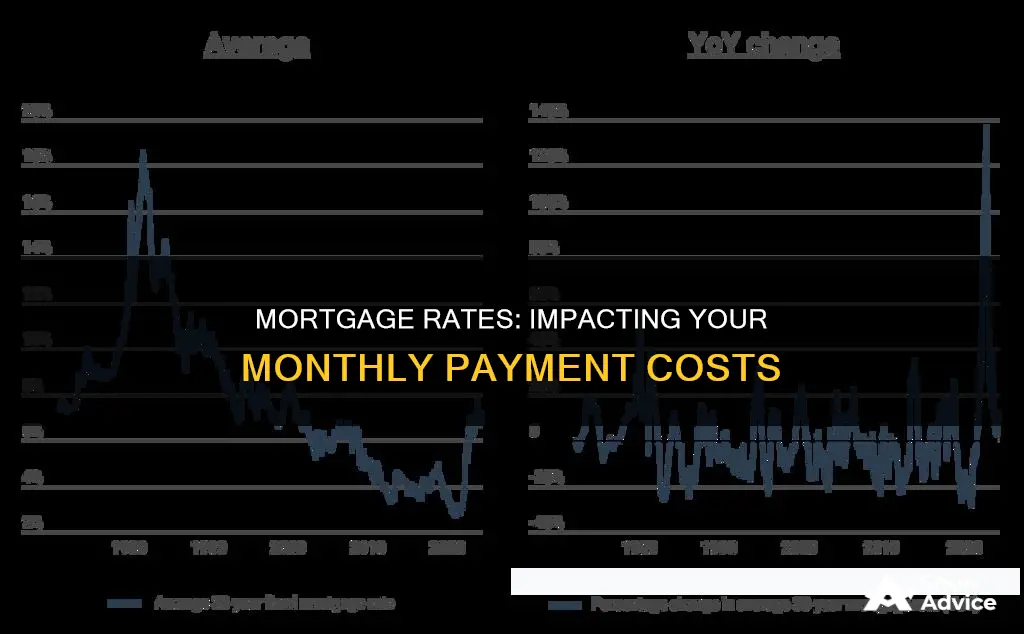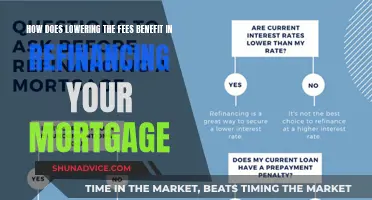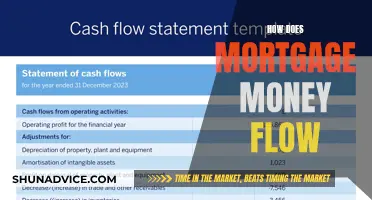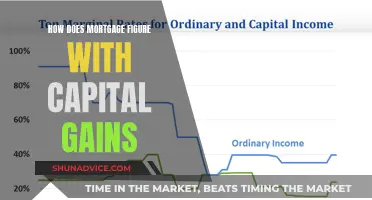
Taking out a mortgage is a big financial decision, and it's important to understand the factors that influence the cost. The interest rate is a key component, with higher rates resulting in higher monthly payments. There are two main types of mortgages: fixed-interest and adjustable-rate. With fixed-interest, the rate remains the same for the loan's duration, while adjustable-rate mortgages are subject to rate changes. A 1% difference in interest rates can lead to significant savings over the life of a loan. Additionally, factors like the loan term, credit profile, down payment, and property taxes impact the overall cost of a mortgage. Online calculators can help estimate monthly payments, and it's advisable to shop around for the best rates.
| Characteristics | Values |
|---|---|
| Interest rate | Directly impacts the size of mortgage payments; higher rates mean higher payments |
| Interest rate type | Fixed-rate mortgages lock in a set interest rate for the buyer, while adjustable-rate mortgages (ARMs) can change after an initial period |
| Loan term | Longer terms result in lower monthly payments but higher overall interest payments |
| Down payment | A larger down payment reduces the size of the loan and can help avoid private mortgage insurance |
| Credit score | A higher credit score can help secure a lower interest rate |
| Debt-to-income ratio (DTI) | A lower interest rate can decrease your DTI, making it easier to qualify for a new home loan |
| Property taxes | Paid with mortgage payments but are a cost of homeownership regardless |
| Homeowner's insurance | Required by lenders and often paid with mortgage payments |
| Origination and lender charges | Charged by the lender for "originating" or making the loan; common fees include origination, application, underwriting, processing, and administrative fees |
| Closing costs | One-time fees associated with getting a mortgage, including lender's origination fee, recording fees, and fees for settlement and title services |
What You'll Learn

The type of mortgage you choose
Fixed-Rate Mortgages
Fixed-rate mortgages offer stability and predictability, as the interest rate remains the same throughout the loan term. This makes budgeting easier and is ideal for borrowers who prefer stable principal and interest payments. The most common fixed-rate options are 15- and 30-year mortgages. However, if you decide to break the contract early, there is usually an early repayment charge, which can add significantly to the overall cost.
Adjustable-Rate Mortgages (ARM)
ARM loans have variable interest rates that fluctuate over the repayment term. While they may provide lower initial interest rates, there is a risk of higher rates in the future, which can increase the total amount owed. With an ARM, it's important to carefully consider the potential impact of rising interest rates on your financial situation.
Conventional Loans
These are mortgages that are not insured or guaranteed by the government. They typically require a higher down payment and stronger credit scores compared to government-backed loans. The interest rates and fees associated with conventional loans can vary depending on the lender and the borrower's financial profile.
Government-Backed Loans
The U.S. government backs several types of mortgages, including FHA loans, VA loans, and USDA-insured loans. These loans are designed to make homeownership more accessible, especially for first-time homebuyers. FHA loans, for example, can be obtained with lower credit scores and down payments as low as 3.5%. However, FHA loans also require mortgage insurance premiums, which add to the overall cost. VA loans, on the other hand, are available to qualified military service members, veterans, and their spouses, and offer benefits such as no down payment and lower closing costs.
Piggyback Loans
Piggyback loans, or 80/10/10 loans, are designed to help borrowers avoid mortgage insurance or taking out a jumbo loan. This type of loan involves two loans: one for 80% of the home price and another for 10%, with a required down payment for the remaining 10%. While piggyback loans can help you avoid mortgage insurance, they also mean incurring two sets of closing costs.
The choice of mortgage type depends on various factors, including your financial situation, credit score, and long-term goals. It is always advisable to research and compare different options before making an informed decision.
Freedom From Mortgage: A Dream Come True
You may want to see also

The interest rate
There are two main types of interest rates: fixed and adjustable. Fixed-rate mortgages lock in an interest rate for the duration of the loan, ensuring that the monthly payments remain the same. Adjustable-rate mortgages (ARMs) have a fixed period, after which the interest rate can change, resulting in fluctuations in monthly payments. While an adjustable-rate mortgage may offer a lower initial interest rate than a fixed-rate mortgage, there is a risk of significant increases later on.
It is worth noting that a larger down payment can result in a lower interest rate, as lenders perceive a lower level of risk when the borrower has more stake in the property. Additionally, the type of property and occupancy status can also impact the interest rate, with single-family homes as a primary residence typically receiving lower rates.

The term of the loan
The term of a loan is the duration of the loan, or the length of time it takes for a borrower to repay the loan in full through regular, scheduled payments. Loan terms can be short (e.g. 15 years) or long (e.g. 30 years or more). The term of the loan will determine how long the borrower will be in debt, as well as the size of their monthly payments and the total amount of interest they will pay.
Shorter loan terms generally translate to higher monthly payments, but lower overall costs. This is because the borrower will be paying interest for a shorter amount of time. For example, a $15,000 loan at a 7.75% APR with a 10-year term would have monthly payments of $180.02, while the same loan with a five-year term would have monthly payments of $302.35.
Longer loan terms, on the other hand, result in lower monthly payments but higher total interest costs over the life of the loan. This is because the interest is applied over a longer period. For example, a 30-year mortgage will have lower monthly payments than a 15-year mortgage, but the borrower will ultimately pay more in interest over the course of the loan.
The loan term is a crucial factor in determining how much interest a borrower will pay over the life of the loan. It is important to carefully consider the different loan terms offered by lenders and to understand how they will impact the total cost of the loan. Tools such as mortgage amortization calculators can be useful in helping borrowers make informed decisions about their loan options.

Your credit profile
Lenders use your credit score to assess your reliability in repaying loans. The score is a numerical representation of your ability to manage debt and pay back credit obligations. A higher score indicates that you are a trustworthy borrower who can handle various financial responsibilities. This is why lenders are more likely to offer favourable terms to borrowers with good credit scores.
There are several ways to improve your credit score before applying for a mortgage. It is important to make timely payments on any existing loans or credit cards, as even one missed payment can lower your score. Keeping your credit utilisation ratio low by paying down balances and reducing your overall credit utilisation can also help improve your score. Additionally, maintaining a long credit history can be beneficial, so it is advisable to keep accounts open even after paying off a balance in full.
It is worth noting that getting pre-approved or applying for a mortgage can cause a temporary dip in your credit score. This is because the application process involves a hard inquiry on your credit report, which can slightly lower your score. Therefore, it is recommended to refrain from borrowing more until your credit score recovers, which typically takes at least a year. During this time, lenders will evaluate your ability to manage your new mortgage, and your score will naturally rise as you make timely payments.

The down payment amount
It's important to note that while a larger down payment can result in lower monthly payments, it may not always be the best financial decision. Emptying out your savings for a large down payment can leave you with limited funds for other expenses, such as repairs, renovations, moving costs, and emergency savings. Therefore, it's crucial to assess your financial situation and consider all associated costs when deciding on the down payment amount.
Additionally, the down payment amount can impact your ability to qualify for a loan. A larger down payment demonstrates your financial stability and commitment to the investment, making lenders more confident in your ability to repay the loan. However, a lower down payment may still be feasible if you have a strong credit history, stable income, and meet other requirements set by the lender.
To summarize, the down payment amount is a crucial factor in determining the cost of your mortgage, and it's important to carefully consider your financial situation, associated costs, and loan requirements when deciding on the appropriate down payment amount.
Frequently asked questions
A mortgage is a long-term loan designed to help you buy a house. It is a type of home loan offered to those who wish to borrow a set amount of funds for the purchase of a piece of real estate property.
The interest rate on a mortgage has a direct impact on the size of a mortgage payment. Higher interest rates mean higher mortgage payments. Lower interest rates mean lower monthly payments.
There are two types of mortgages: fixed-interest rate mortgages and adjustable-rate mortgages. Fixed-interest rate mortgages lock in a set interest rate for the buyer, while adjustable-rate mortgages have interest rates that can change after an initial period.
In addition to the interest and principal payments, there are several other costs associated with a mortgage. These include property taxes, homeowner's insurance, closing costs, origination fees, application fees, and more.







